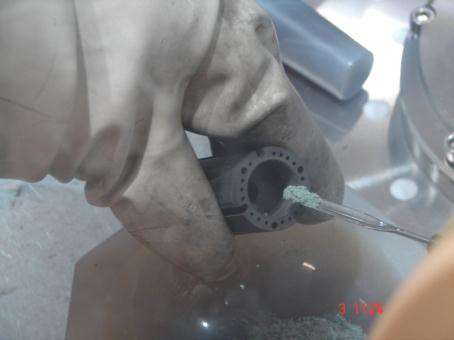August 27, 2017 weblog
Scientists in the Netherlands swing into action on thorium molten salt reactor experiments

(Tech Xplore)—Researchers at the Nuclear Research and Consultancy Group (NRG) in the Netherlands have begun experiments for the first time in many years to test thorium molten salt reactors. The experiments, in Petten, mark the first of its kind in over 45 years.
A post in Medium from Gijs Zwartsenberg, chairman, the Thorium MSR Foundation, [MSR stands for molten salt reactor] spelled it out: "On August 10, 2017, a set of concentric sealed tubes was entered into the core of the High Flux Reactor in Petten, Netherlands. In the smallest of these tubes sits an even smaller set of four graphite crucibles, containing a mixture of salts: lithium fluoride and thorium fluoride."
Responding to the news, The Engineer said thorium reactor research has reached a "new dawn." Thorium hopefuls think it could power the next generation of nuclear reactors.
Steven Ashley in New Scientist said the researchers "want to use thorium as a fuel for a molten salt reactor, one of the next generation designs for nuclear power."
Ashley said, "because nuclear power was traditionally tied up with nuclear weapons research, thorium was abandoned. Except for one test reactor that has been under construction in India since 2004, the last research into thorium reactors took place 45 years ago." Nonetheless, "Molten salt reactors are expected to be very well suited for using thorium as a fuel. The unique fluid fuel can incorporate thorium and U-233 fluorides as part of a salt mixture, to melt at very high temperatures."
Supporters think that thorium as an alternative to uranium could provide a cleaner, safer fuel source.
MIT Technology Review newsletter, "The Download" wrote that "Thorium has several advantages over uranium, the fuel that powers most nuclear reactors in service today. First, it's much harder to weaponize. Second, as we pointed out last year in a long read on thorium-salt reactors, designs that call for using it in a liquid form are, essentially, self-regulating and fail-safe."
(As mentioned earlier, "because nuclear power was traditionally tied up with nuclear weapons research, thorium was abandoned.")
Specifically, the August news centers around the Salt Irradiation Experiment (SALIENT) at the NRG research area in Petten.
The NRG describes itself as an internationally operating nuclear service provider. The company produces isotopes, conducts nuclear technological research, is a consultant on the safety and reliability of nuclear installations and provides services related to radiation protection.
The experiments are divided into steps and of course there are learning goals.
In the beginning step, the Petten team "will melt a sample of thorium salt fuel to see if, over time, the neutron bombardment triggers the nuclear reactions necessary to transmute the thorium into uranium isotopes that can undergo nuclear fission, and sustain the chain reaction needed to generate energy," said Ashley.
New Scientist walked readers through the steps to follow. "The next step is to study tough metal alloys and other materials that can survive the bombardment. Later research will examine how to deal with the waste from a molten salt thorium reactor. While safer than the long-lived products from a standard nuke, these will still need special disposal."
The discussion in Medium, in answer to why the team chose the lithiumfluoride/thoriumfluoride mixture as a start for their tryouts, said that was the salt of choice for the Molten Salt Fast Reactor (MSFR). That is a European concept for a waste-burning MSR. "For SALIENT-02, we will use a different mixture that will also contain beryllium, forming a mixture also known as FliBe, and uranium as the fuel."
Zwartsenberg's post in Medium quoted nuclear fuels expert and NRG scientist Ralph Hania: "SALIENT is a way to build up experience with the use of fission fuel in the form of a molten salt. That hasn't been done for decades and we're also doing it to train ourselves. It's important to notice that SALIENT is not a single experiment but really a series, and we'll build that up step by step. On the other hand, it is fundamental research, in which we look at the behavior of salt and the fission products that are formed in the salts."
What is the future of thorium? Ashley in New Scientist: "We need clean energy sources to stave off climate change, yet fears raised by Fukushima have caused nuclear power to stagnate. Maybe thorium's time has finally come."
The Thorium Energy World site: "Success at Petten might push countries like India to develop their technology faster; it may also give impetus to American startups, who have had some interesting ideas but struggle without the required funding and legislation to make them serious projects."
Still, US scientists interested in thorium's potential are not deterred. New Scientist reported that "A US startup based in Utah says it's developing a thorium reactor, the first in the U.S. in half a century, and a consortium of eastern Utah counties is exploring whether to participate in the project. Last month, Utah's Seven County Infrastructure Coalition issued a request to evaluate 'a thorium energy facility for producing electricity'."
© 2017 Tech Xplore

















